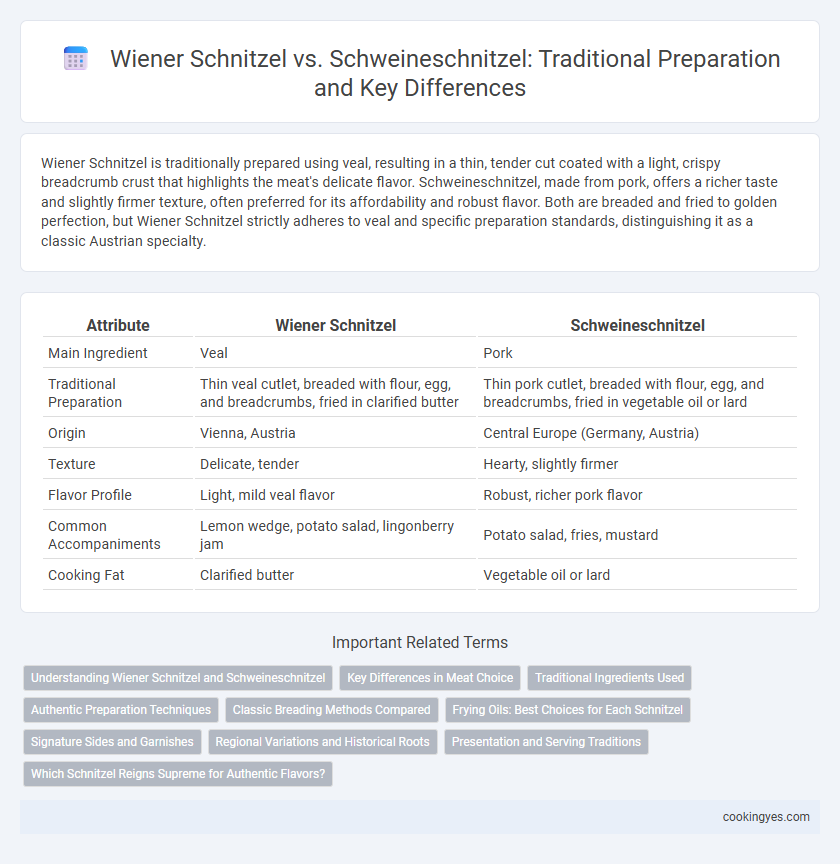Wiener Schnitzel is traditionally prepared using veal, resulting in a thin, tender cut coated with a light, crispy breadcrumb crust that highlights the meat's delicate flavor. Schweineschnitzel, made from pork, offers a richer taste and slightly firmer texture, often preferred for its affordability and robust flavor. Both are breaded and fried to golden perfection, but Wiener Schnitzel strictly adheres to veal and specific preparation standards, distinguishing it as a classic Austrian specialty.
Table of Comparison
| Attribute | Wiener Schnitzel | Schweineschnitzel |
|---|---|---|
| Main Ingredient | Veal | Pork |
| Traditional Preparation | Thin veal cutlet, breaded with flour, egg, and breadcrumbs, fried in clarified butter | Thin pork cutlet, breaded with flour, egg, and breadcrumbs, fried in vegetable oil or lard |
| Origin | Vienna, Austria | Central Europe (Germany, Austria) |
| Texture | Delicate, tender | Hearty, slightly firmer |
| Flavor Profile | Light, mild veal flavor | Robust, richer pork flavor |
| Common Accompaniments | Lemon wedge, potato salad, lingonberry jam | Potato salad, fries, mustard |
| Cooking Fat | Clarified butter | Vegetable oil or lard |
Understanding Wiener Schnitzel and Schweineschnitzel
Wiener Schnitzel is a traditional Austrian dish made exclusively from veal, breaded and fried to a golden crisp, emphasizing tenderness and delicate flavor. Schweineschnitzel, commonly prepared in Germany, uses pork loin instead of veal, offering a heartier taste and slightly firmer texture while following a similar breading and frying method. Understanding these distinctions highlights the cultural heritage and ingredient specificity that define authentic Wiener Schnitzel versus the more widely accessible Schweineschnitzel.
Key Differences in Meat Choice
Wiener Schnitzel is traditionally made from veal, prized for its tender texture and delicate flavor, whereas Schweineschnitzel uses pork, offering a slightly richer taste and firmer bite. The key difference lies in the meat's origin and texture, with veal being leaner and more refined, while pork delivers a heartier, more robust character. Authentic Wiener Schnitzel must be veal to meet culinary standards, while Schweineschnitzel provides an affordable and widely popular alternative without compromising the classic breaded and fried preparation.
Traditional Ingredients Used
Wiener Schnitzel traditionally uses veal, coated in a simple mixture of flour, eggs, and finely ground breadcrumbs, emphasizing lightness and crispiness. Schweineschnitzel, made from pork, often includes the same basic coating but may incorporate coarser breadcrumbs or additional seasonings to enhance flavor. Both preparations rely on fresh, high-quality meat and minimal seasoning to highlight the natural taste and texture of the schnitzel.
Authentic Preparation Techniques
Wiener Schnitzel uses veal thinly pounded, coated in flour, egg wash, and fine breadcrumbs, then fried in clarified butter to achieve a crisp, golden crust. Schweineschnitzel traditionally utilizes pork cutlets prepared using the same breading technique but often fried in vegetable oil or lard to enhance flavor and juiciness. Authentic preparation emphasizes gentle pounding to maintain tenderness and frying at moderate temperatures to prevent sogginess or burning.
Classic Breading Methods Compared
Wiener Schnitzel traditionally uses veal coated in flour, eggs, and fine breadcrumbs, creating a delicate, crispy crust that remains light and airy after frying. Schweineschnitzel, made with pork, often features coarser breadcrumbs and may include seasoning blends, resulting in a heartier texture and richer flavor profile. Both methods emphasize dry breadcrumbs over wet batters for optimal crunch and ensure even coating through gentle pressing and immediate frying in clarified butter or oil.
Frying Oils: Best Choices for Each Schnitzel
Wiener Schnitzel, traditionally made from veal, is best fried in clarified butter or a blend of clarified butter and vegetable oil to achieve a delicate, nutty flavor and crisp texture without burning. Schweineschnitzel, typically pork-based, benefits from frying in neutral oils like sunflower or canola oil, which withstand higher temperatures and allow the schnitzel to develop a golden, crunchy crust. Choosing the right frying oil enhances the authenticity and taste profile of each schnitzel variety while ensuring ideal frying conditions.
Signature Sides and Garnishes
Wiener Schnitzel traditionally features a veal cutlet, breaded and fried to a crisp golden brown, often served with a lemon wedge, parsley potatoes, and lingonberry sauce for a balanced tangy finish. Schweineschnitzel, made from pork, is commonly accompanied by potato salad, cucumber salad, or fries, emphasizing heartier, rustic flavors. Both dishes are typically garnished with fresh parsley and a slice of lemon to enhance their savory profiles and maintain authentic Austrian culinary traditions.
Regional Variations and Historical Roots
Wiener Schnitzel, a traditional Austrian dish made exclusively from veal, embodies the culinary heritage of Vienna with its delicate, thinly pounded cutlets and crisp golden breadcrumb coating. Schweineschnitzel, popular in Germany and parts of Central Europe, uses pork instead of veal, reflecting regional adaptations based on locally available meats and economic factors. The historical roots trace Wiener Schnitzel to 19th-century Viennese cuisine, while Schweineschnitzel variations have evolved through practical, cost-effective approaches in rural and working-class communities.
Presentation and Serving Traditions
Wiener Schnitzel is traditionally presented thin, golden-brown, and garnished with a lemon wedge and parsley, served alongside potato salad or cucumber salad to highlight its Viennese heritage. Schweineschnitzel, often thicker and breaded with coarser crumbs, is commonly accompanied by heavier sides like fries, sauerkraut, or mashed potatoes, reflecting its Germanic rustic roots. Both dishes emphasize crispiness and balanced acidity but differ in plating style and regional serving customs.
Which Schnitzel Reigns Supreme for Authentic Flavors?
Wiener Schnitzel, made from tender veal, is the gold standard for traditional Austrian cuisine due to its delicate texture and subtle flavor, perfectly breaded with a light coating of flour, egg, and breadcrumbs before frying in clarified butter. Schweineschnitzel uses pork, offering a heartier and slightly more robust taste, but lacks the authentic tenderness that characterizes a true Wiener Schnitzel. For purity of authentic flavor and traditional preparation, Wiener Schnitzel reigns supreme, celebrated worldwide for its refined culinary heritage.
Wiener Schnitzel vs Schweineschnitzel for traditional preparation Infographic

 cookingyes.com
cookingyes.com